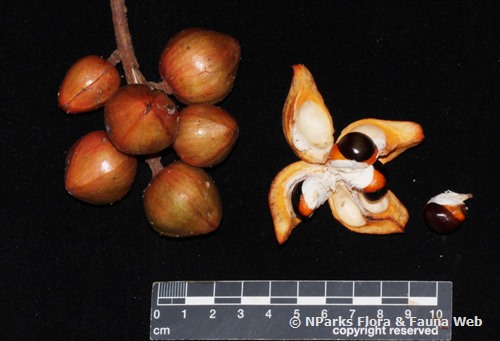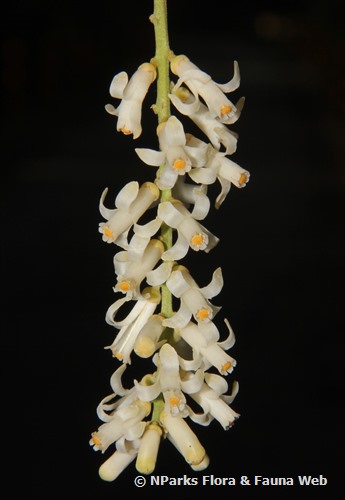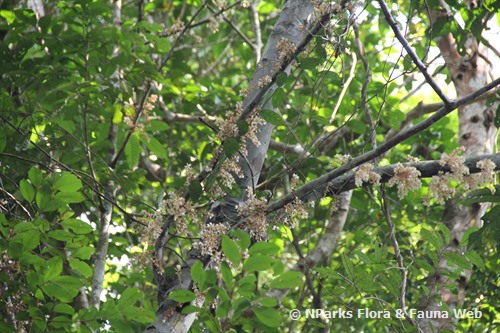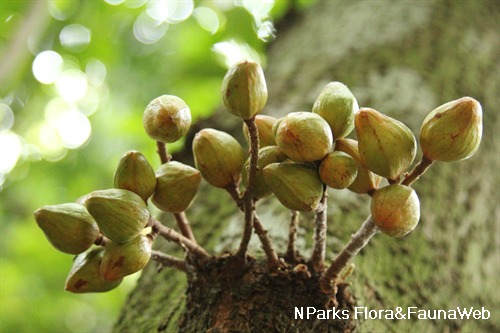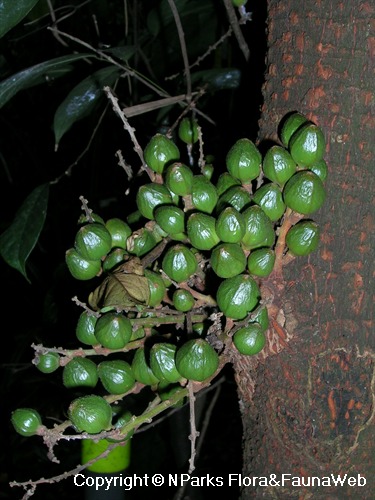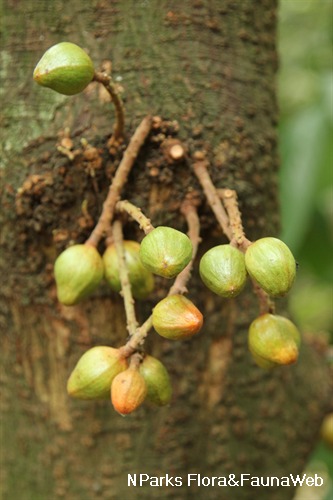
Back
Epicharis cuneata (Hiern) Harms
| Family Name: | Meliaceae |
| Synonyms: | Dysoxylum cauliflorum Hiern |
| Common Name: | Stem Dysoxylon, Dedali, Guatak, Pokok Parong, Pudu Sawa |
Name
Classifications and Characteristics
| Plant Division | Angiosperms (Flowering Seed Plants) (Dicotyledon) |
|---|---|
| Plant Growth Form | Tree (Medium (16m-30m)) |
| Lifespan (in Singapore) | Perennial |
| Mode of Nutrition | Autotrophic |
| Plant Shape | Irregular |
| Maximum Height | 30 m |
Biogeography
| Native Distribution | Thailand, Cambodia, Vietnam, Sumatra, Bangka, Peninsular Malaysia, Singapore, Borneo, and Philippines |
|---|---|
| Native Habitat | Terrestrial (Primary Rainforest, Secondary Rainforest, Freshwater Swamp Forest) |
| Preferred Climate Zone | Tropical |
| Local Conservation Status | Native to Singapore (Vulnerable (VU)) |
Description and Ethnobotany
| Growth Form | It is a dioecious tree up to 30 m tall, with male and female flowers on separate individuals. Its smooth, grey bark is covered with lenticels. Its clusters of flowers and fruits are found on the tree trunk and main branches, usually from ground level up. |
|---|---|
| Foliage | Its spirally arranged, stalked, pinnate leaves are up to 60 cm long, with 4–6 pairs of leaflets. The opposite, stalked leaflets have leaf blades that are egg-shaped-elliptic to egg-shaped, about 30 by 7 cm, and covered with hair. Its terminal leaflets are drop-shaped. The stalks of the leaflets are swollen at the base. |
| Flowers | Its flowering spikes are up to 8 cm long. Its white to pinkish or cream flowers are sweetly scented and smell like almond and musk. |
| Fruit | Its 3–5-chambered red fruit is top-shaped and 4 cm wide, and develops either solitarily or in clusters from the trunk. Its fruit wall has milky latex. The seeds are 2 cm long and about 1–4 per fruit. |
| Habitat | It grows in rainforests up to 1,500 m altitude. It occurs locally in Central Catchment Nature Reserve, along Chestnut Track, in the vicinity of Kallang Reservoir, and Nee Soon Swamp Forest. |
| Associated Flora | Its flowers are insect-pollinated. |
| Cultivation | It can be propagated by seed. |
| Ethnobotanical Uses | Medicinal: A poultice made from its fruit is used to treat rheumatism, whereas a poultice from the root is effective against abdominal pains. Timber & Products: It is a source of timber. |
Landscaping Features
| Landscaping | It may be suitable for parks. |
|---|---|
| Desirable Plant Features | Fragrant (Flowers) |
| Landscape Uses | General, Parks & Gardens, Small Gardens |
| Thematic Landscaping | Naturalistic Garden, Fragrant / Aromatherapy Garden |
Fauna, Pollination and Dispersal
| Pollination Method(s) | Biotic (Fauna) |
|---|
Plant Care and Propagation
| Light Preference | Full Sun |
|---|---|
| Water Preference | Moderate Water |
| Plant Growth Rate | Moderate |
| Rootzone Tolerance | Moist Soils, Well-Drained Soils, Fertile Loamy Soils |
| Maintenance Requirements | Moderate |
| Propagation Method | Seed |
Foliar
| Foliage Retention | Evergreen |
|---|---|
| Mature Foliage Colour(s) | Green |
| Foliar Type | Compound (Odd-Pinnate) |
| Foliar Arrangement Along Stem | Spiral |
| Foliar Shape(s) | Non-Palm Foliage (Ovate, Elliptical) |
| Foliar Venation | Pinnate / Net |
| Foliar Margin | Entire |
| Leaf Area Index (LAI) for Green Plot Ratio | 3.0 (Tree - Intermediate Canopy) |
Floral (Angiosperm)
| Flower & Plant Sexuality | Unisexual Flowers , Dioecious |
| Flower Colour(s) | White, Pink, Cream / Off-White |
|---|
| Flower Grouping | Cluster / Inflorescence |
| Flower Location | Cauliflorous |
Fruit, Seed and Spore
| Fruit Classification | Simple Fruit |
|---|---|
| Fruit Type | Dehiscent Dry Fruit |
Image Repository
Others
| Master ID | 1574 |
|---|---|
| Species ID | 2867 |
| Flora Disclaimer | The information in this website has been compiled from reliable sources, such as reference works on medicinal plants. It is not a substitute for medical advice or treatment and NParks does not purport to provide any medical advice. Readers should always consult his/her physician before using or consuming a plant for medicinal purposes. |

